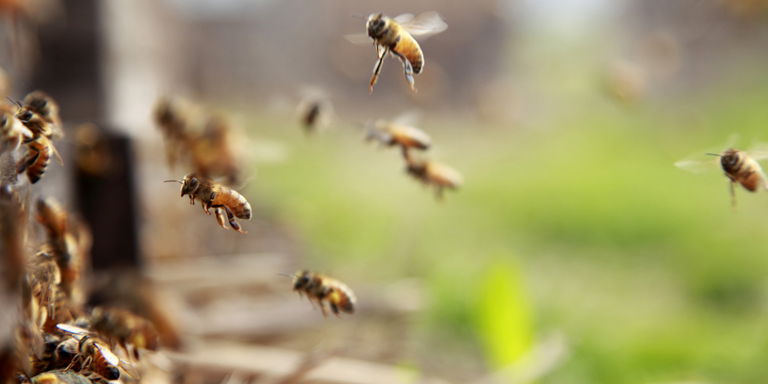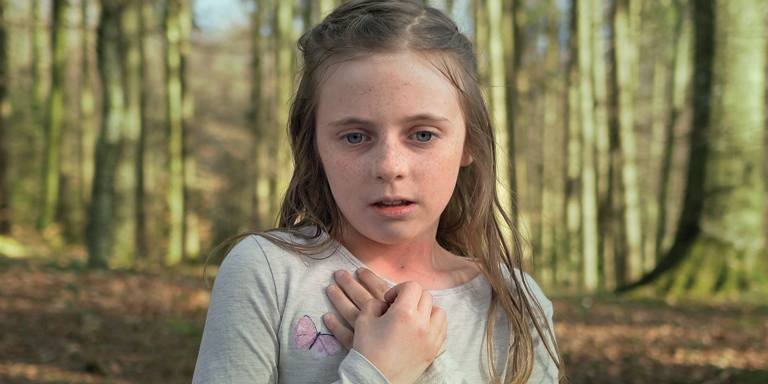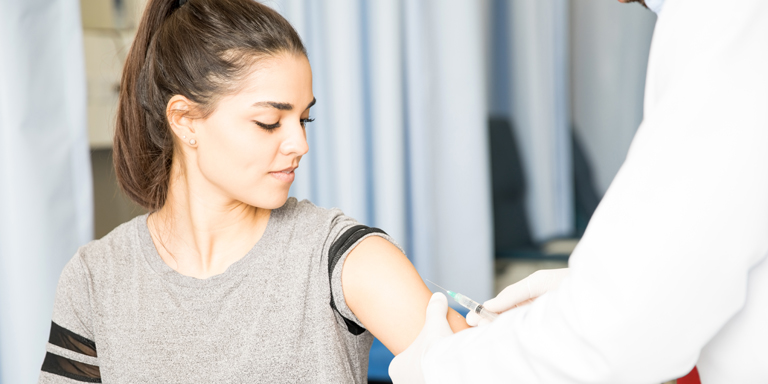Insect venom allergies
Bee stings occur mainly in spring and summer, whereas wasps are active in late summer and autumn. Their stings can trigger life-threatening reactions in the event of an allergy. Sufferers should therefore always carry an emergency kit with them.

Table of contents:
Allergic reactions to insect venom are mainly caused by stings from bees or wasps. A sting in the mouth or throat can lead to life-threatening swelling even in non-allergic individuals. In Switzerland, around 3 to 4 people die every year from an insect venom allergy.
Trigger
In Europe, it is mainly bees and wasps that cause insect venom allergies. Unlike wasps, bees lose their stinger after stinging and die in the process. Hornets, which are related to wasps, are larger and less aggressive. They sting less frequently. Bumblebees, which are related to bees, sting very rarely and their stings are generally harmless. Other insects such as (exotic) ants or, in very rare cases, mosquitoes can trigger allergies. As an insect venom allergy is not hereditary, children of parents with the allergy are not at increased risk of also being affected.
Symptoms
The first symptoms of an allergic reaction usually occur within minutes of the sting. They affect the whole body and can range from skin symptoms (itching, hives) to swelling of the eyes and lips, nausea, abdominal pain, breathing difficulties or palpitations to allergic shock (anaphylaxis).
If the symptoms remain limited to the site of the sting, it is not usually an allergic reaction. In this case, a distinction is made between normal local reactions and severe local reactions.
A swelling of up to 10 cm in diameter is considered a normal reaction to an insect bite. It may be accompanied by redness and an unpleasant itching sensation, which usually subsides within 24 hours. However, the itching at the site of the bite itself can last for several days.
Treatment: Cool the puncture site to relieve the pain and reduce swelling. If the itching is severe, an antihistamine can also help, or a painkiller if the pain is severe.
A severe local reaction is present if the swelling at the puncture site is more than 10 cm in diameter and lasts longer than 24 hours. This swelling can be painful and annoying and sometimes worries those affected. However, such a local reaction is not usually dangerous - except in the case of stings in the mouth or throat. The swelling can spread considerably: the whole leg can swell after a sting in a toe or the whole arm after a sting in the finger. This swelling can last up to a week. In the case of a severe local reaction, there is also often slightly painful swelling in the groin or armpits. General malaise and fever may also occur.
Treatment: It helps to cool the puncture site and elevate the affected part of the body. Antihistamines can be taken for severe itching and painkillers for severe pain. In the case of stings in the mouth or throat that cause swelling, it is recommended to call the emergency services.
Diagnosis
If an allergic reaction is suspected following a bee or wasp sting, a specialist should carry out a detailed interview to confirm the allergic reaction and, where possible, identify the insect that caused it. Skin and blood tests can then be carried out to confirm the diagnosis.
Good to know: For people who have never had an allergic reaction to an insect bite, there is no "preventive" test that can predict the risk of allergy.
Therapy
Those who are allergic to insect venom should always carry an emergency kit prescribed by a doctor.
This usually contains antihistamines and an adrenaline autoinjector. In some cases, a cortisone-based medication may also be included. In the event of a sting, the prescribed medication must be taken immediately without waiting for symptoms to appear. In the event of a severe allergic reaction (anaphylaxis), the adrenaline autoinjector must be used and the emergency services alerted.
More information on anaphylaxis
Allergen-specific immunotherapy (desensitisation) is the only effective therapy that treats the cause of the allergy. The treatment lasts between 3 and 5 years and leads to complete protection in 80-85% of bee venom allergy sufferers and up to 95% of wasp venom allergy sufferers.
More information on allergen-specific immunotherapy
Tips and tricks
- Wasps or bees are rarely alone. Avoid the vicinity of bee colonies or wasp nests (near the ground, in rotten branches and hollow tree trunks, in roller shutter boxes or in the screed).
- Keep your distance from flowers and flowering trees/shrubs and do not walk barefoot on meadows and at the edge of woods.
- Do not wear loose, flapping clothing.
- Wear long-sleeved clothing, long trousers and gloves when gardening.
- Do not make rapid movements in the vicinity of these insects.
- Do not use strongly perfumed hairsprays, shampoos or sun creams.
- Always wear a closed helmet, gloves and clothing that covers the body when riding a motorcycle.
- Install insect screens, especially in bedrooms.
- Report swarms of bees or wasp nests in the immediate vicinity of your home or place of work to the fire department or a beekeeper.
- Wasps love our food: be careful when picnicking and eating outdoors: don't leave any leftovers lying around.
- Beer and sweet drinks attract wasps, never drink directly from bottles or cans.
- When bees sting, their stinger gets stuck in the skin. It is important to remove it immediately without squeezing the venom sac (pull the stinger out at the base instead of squeezing it between your fingers).
Special case: beekeepers
Beekeepers and their relatives have a higher risk of being stung by bees and developing a bee venom allergy. Allergen-specific immunotherapy is therefore also recommended for mild general reactions such as eye swelling or hives, especially if the individual wishes to continue keeping bees.
As there is a risk of being stung several times simultaneously, a higher maintenance dose is aimed for during therapy. In addition, immunotherapy must be continued for as long as the idividual concerned works with bees due to the significantly higher risk of stings.
Facts and figures
In Switzerland, an estimated 3.5% of the population suffer from an insect venom allergy.
Editors: aha! Swiss Allergy Centre in co-operation with the Scientific Advisory Board.
Final revision of the website content: 26.11.2024


